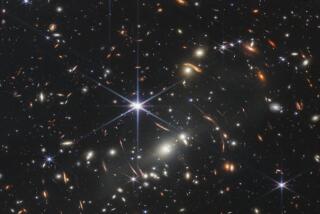SCIENCE FILE : MIND OVER MATTER / K.C. COLE : The Question Is: What’s Not Out There?
- Share via
Everyone knows that scientists investigate the nature of the universe around them. Few people consider, however, how much time scientists spend studying things that can’t be found in the universe at all.
Indeed, what’s not in the universe is often as telling as what is. Sometimes, more so.
Physicists, in particular, spend a good portion of their time investigating the properties of things that are missing, don’t matter, don’t exist, or are generally AWOL.
Take the notorious case of the missing matter. Astronomers can clearly see that galaxies spin around one another in clusters at speeds fast enough to send these cosmic pinwheels flying into space like water droplets off a salad spinner. Yet the galaxies somehow stay stuck in enormous globs. The only force that could glue the galaxies together is gravity. Yet gravity comes from mass, and astronomers see only about 10% of the matter necessary to produce that much gravity. The rest can’t be found.
In the universe as a whole, the problem is even worse: The large-scale structure of matter in the cosmos suggests that as much as 99% of the matter may be absent from the universe without official leave.
Or consider the missing neutrinos. Astrophysicists have a pretty good idea what makes the sun shine--nuclear fusion. But these well-understood fusion reactions should shower the Earth with untold numbers of practically nonexistent particles called neutrinos--”little neutral ones.” Trouble is, only about a third of the predicted number actually seem to arrive on Earth. The rest get lost on their journey from the sun to scientists’ detectors. Physicists think they may be cosmic shape-shifters, changing chameleon-like from one form to another en route.
Other missing entities abound--magnetic monopoles, for example. These never-seen particles would be magnetism’s counterpart to the electron--a single electric charge. The negatively charged electron can stand on its own, as can the positively charged proton.
But magnetic fields, for some reason, always come with north and south poles permanently attached. Why aren’t there single north or south poles? Theories suggest these monopoles should be floating out there somewhere.
One might well wonder: What’s the appeal of all these missing whatnots? Why do scientists waste their time studying what can’t be found, when so much is right in front of their noses?
One answer is that finding the missing pieces helps to prove--or disprove--the theories that suggest they should exist in the first place. In the past, physicists have found elusive entities such as antimatter, quarks and even neutrinos through just such searches.
*
But even searches that come up empty-handed are uncannily useful. In Einstein’s day, physicists were busily exploring the properties of the luminiferous ether--the pervasive medium that everyone assumed carried waves of light like air carries waves of wind. Clever experiments confirmed that the ether did not exist. Einstein’s revolutionary insights on the nature of light, space and time later explained why nature didn’t require an ether at all.
And so it goes. What’s not is as significant as what is. Mathematicians even study knots by exploring the spaces the knots don’t occupy. These empty spaces are known in the trade as “not knots.”
To physicists, in fact, there’s probably nothing more important than things that don’t matter or don’t happen. For example, certain properties of the universe always stay the same. The total amount of electric charge is a constant, as is the total amount of energy or momentum.
These so-called “conserved quantities” form the bedrock of physics. They tell us that certain things can’t disappear, no matter what, that certain things can never change. Every time physicists discover another thing that does not happen, they create a new “conservation law” to account for it.
“All conservation laws are invented to explain what does not happen,” said physicist Helen Quinn of the Stanford Linear Accelerator Center.
Indeed, the main goal of physics is to discover which properties of the universe survive every kind of shape-shifting and stay the same no matter what. The energy from the sun can get soaked up by a plant to grow green grass, which can be eaten by a cow, which can be eaten by a child munching a burger, which fuels the child to climb the tree. It doesn’t matter which form the energy takes. The total amount never changes.
Most curious of all, adding up all the positive and negative energy in the universe gives you zero. The total positive and negative electric charge also adds up to zero. So does the total amount of matter and antimatter.
All the quantities appear to exactly cancel out. When you add them up, all the fundamental attributes of the cosmos disappear into nothingness.
This leads to an interesting speculation. The universe itself could have arisen from nothing at all. Cosmologists are searching for the answer. One of these days, they’ll probably find it.
Or not.





